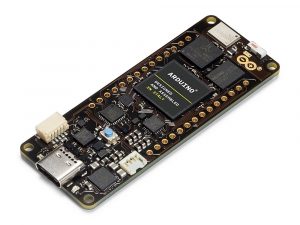The New Arduino Portenta H7
The Portenta can perform in two ways, it can either work like any other embedded microcontroller board, or as the core processor of an embedded computer.

Arduino recently developed a new board designed specifically for high and rigid performance to meet the industry requirements and accelerate the industry growth. The CES 2020 held in Las Vegas, USA, was the platform where Arduino launched the brand new, low power consumption, dual core industrial board- The Arduino Portenta H7. Program it with high-level languages and AI while performing low-latency operations on its customizable hardware.
Portenta H7’s high customization not only serves the complex industrial requirements but is also made for mission critical applications, robotics, computer vision, Laboratory equipment and lot more.
The Portenta can perform in two ways, it can either work like any other embedded microcontroller board, or as the core processor of an embedded computer.
The Arduino Protenta H7 (also known as Arduino Pro) consists of Two Processors that are capable of performing tasks in parallel. For example, Protenta H7 can deal with Arduino assembled code alongside MicroPython one, and have both of its cores inter connected to one another.
“By combining the power and flexibility of our production-ready IoT hardware with our secure, scalable and easy to integrate cloud services, we are putting in the hands of our customers something really disruptive,” said CEO Fabio Violante. He added “Among the millions of Arduino customers, we’ve even seen numerous businesses transform from traditional ‘one-off’ selling to subscription-based service models, creating new IoT-based revenue streams with Arduino as the enabler. The availability of a huge community of developers with Arduino skills is also an important plus.”
Features
Dual Core:-
The Arduino Pro’s main processor is the dual core STM32H747 including a Cortex® M7 running at 480 MHz and a Cortex® M4 running at 240 MHz. The two cores interact by means of a Remote Procedure Call system that permits calling capacities on the other processor consistently. The two processors share all the in-chip peripherals and can run:
- Arduino sketches on top of the Arm® Mbed™ OS
- Native Mbed™ applications
- MicroPython / JavaScript via an interpreter
- TensorFlow™ Lite
USB Type C:-
The board's modifying connector is a USB-C port that can likewise be utilized to control the board, as a USB Hub, to interface a DisplayPort screen, or to convey power to OTG gadgets.
Enhanced Graphics
Arduino Pro holds the potential of connecting to an external display which enables us to make our own Embedded computer comprising of an User Interface. This is possible only because of the STM32H747 processor's on-chip GPU, the Chrom-ART Accelerator™. The chip even includes a JPEG encoder and decoder.
High Customizations:-
The new standout two 80 pins high density connectors on the board provides opportunities for lot of customizations enabling it for a wide range of applications by upgrading the Protenta to suit our requirements.
In the event that you need more memory, Portenta H7 can have up to 64 MB of SDRAM, and 128 MB of QSPI Flash. Pair it with an outer UFL connector for adding a higher value antenna to the board. You can choose between crypo-chips from Microchip® and NXP.
Connectivity:-
The Arduino Protenta H7’s on board wireless module offers WiFi and Bluetooth® connectivity. The WiFi can deliver up to 65mbps transfer speed. It can function as an Access Point or as a Station or as both dual mode AP/STA.
Bluetooth® module comes with Bluetooth Classic and BLE support. It is also holds the capacity to execute numerous wired interfaces like UART, SPI, Ethernet, or I2C, both with the help of the MKR styled connectors, or through the new Arduino industrial two 80 pin connectors.
The Arduino Portena H7 will be ready for shipment approximately at the end of March 2020.
Key specs:-
|
MAIN PROCESSOR |
STM32H747XI dual Cortex®-M7+M4 32bit low power Arm® MCU |
|
SDRAM |
8-64 MByte option |
|
QSPI FLash |
2-128 MByte option |
|
Ethernet |
10/100 Phy option |
|
Wireless |
BT5.0 + WiFi 802.11 b/g/n 65Mbps option |
|
Crypto Chip |
ECC608 or SE050C2 (Common Criteria EAL 6+) option |
|
DISPLAY CONNECTOR |
MIPI DSI host & MIPI D-PHY to interface with low-pin count large displays |
|
GPU |
Chrom-ART graphical hardware Accelerator™ |
|
TIMERS |
22x timers and watchdogs |
|
UART |
4x ports (2 with flow control) |
|
SD Card |
Interface for SD Card connector (through expansion port only) |
|
OPERATIONAL TEMPERATURE |
-40 °C to +85 °C (excl. Wireless module) / -10 °C to +55 °C (incl. Wireless module) |
|
POWER |
Through USB-C connector or LiPo battery (integrated charger) |
|
CURRENT CONSUMPTION |
2.95 μA in Standby mode (Backup SRAM OFF, RTC/LSE ON) |
|
USB-C |
Host / Device, DisplayPort out, High / Full Speed, Power delivery |
|
MKR HEADERS |
Use any of the existing industrial MKR shields on it |
|
HIGH DENSITY CONNECTORS |
Two 80 pin connectors will expose all of the board's peripherals to other devices |
|
ESLOV CONNECTOR |
Arduino's open connector standard for self-identifiable hardware |
|
CAMERA INTERFACE |
8-bit, up to 80 MHz |
|
ADC |
3× ADCs with 16-bit max. resolution (up to 36 channels, up to 3.6 MSPS) |
|
DAC |
2× 12-bit DAC (1 MHz) |
Source: Arduino
(Image source: Arduino)







